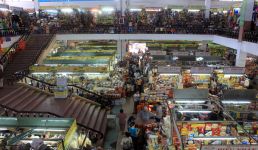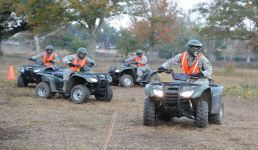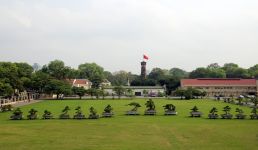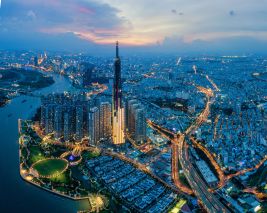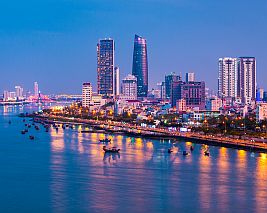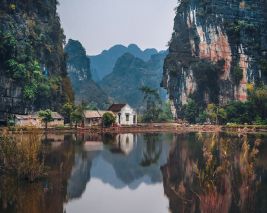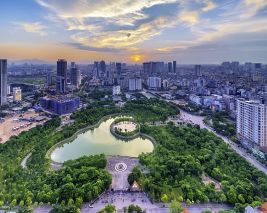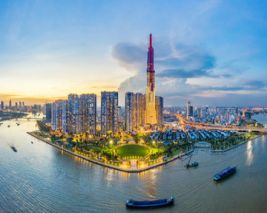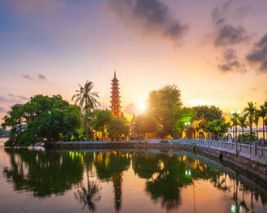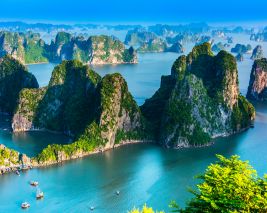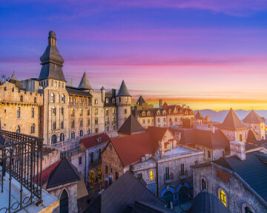Vietnam – Vibrant, colourful, joyful
Vietnam is a land of contradictions. Here you will find sleepy villages and hill tribes barely a few hours away from modern, bustling cities. The natural, majestic landscapes of the country find their twin in beautifully landscaped gardens and tree-lined boulevards. There are massive towering structures that stand next to colonial houses. Everywhere you look, there is beauty, complexity and vibrancy. Despite the immense suffering of the war, Vietnam today is a happy place, with colour and a zest for life evident in every corner.
| Country |
Vietnam |
| Official Language |
Vietnamese |
| Dial Code |
+84 |
| Population |
94.6 million (2016) |
| Currency |
Vietnamese Dong |
| Time Zone |
(GMT+7) |
| Area |
331,212 square kilometres |
Highlights of Vietnam:
Monuments
Vietnam has a rich and varied past, and its influences can be seen throughout the country in the various monuments that dot the nation. You can walk along the narrow streets of the old trading towns of Dong Van, Hue and Hoi An, and be mesmerised by the exceptionally preserved houses, canals and bridges. Allow your eyes to scale up the fortified citadels and castles of Vietnam. Many of the structures follow the feng-shui principles, and are considered to be among some of the earliest applications of this city planning philosophy. The Citadel of the Ho Dynasty, Dien Khanh Citadel, Hue Imperial City and Long Wall of Quang Ngai are some of the ancient monuments that you must visit when in Vietnam.
The country has always been big on religion, and you will find several Buddhist shrines and Hindu temples spread across Vietnam. The But Thap Temple, Dau Pagoda and One Pillar Pagoda are some fine examples of Vietnamese Buddhist architecture. Duong Long towers and My Son are temples built as early as the 4th century and they have withstood the ravages of time to bring to us the rich architectural styles of an era long gone. War tunnels, bridges and ancient tombs complete the tour of some iconic manmade monuments of Vietnam.
Natural beauty in Vietnam
Vietnam is a potpourri of natural landmarks. It's a land of forests, mountains, lakes and flat land, each with its own charm. Some of the most famous landmarks of Vietnam are the stunning rock formations around Bam ha lake in Dau be Island and the Ha Long Bay with its exotic floating fishing villages. Do visit the natural cave formations at Ca Xia cave, Paradise cave and Phone Nha. If you plan your trip to Vietnam during or just after the monsoon the land will be studded with marvellous waterfalls that make their way down the mountainous slopes to thunder down on the land. Ban Gioc Falls, Detian Falls, and Pongua Falls are spectacular falls that you must not miss. Also, do make time for the magnificent forests and tree ecosystems that have been painstakingly nurtured back to life.
Wildlife of Vietnam
Vietnam is a landmass with a thick canopy of forests and hills. The country is known for its rich flora and fauna, and a visit to this land is sure to appeal to the wildlife enthusiast in you. The nation has several national parks, created with the intent of giving visitors access to reserved areas while also creating a demand for ecotourism. Among the national parks and reserves that you must visit are Xuan Thuy Wetland National Park, Ha Long Bay and Phong Nha-Ke Bang National Parks, Cuc Phuong National Park, the Con Dao National Park, the Cat Tien National Park and Con Dao National Park. Vietnam had a rich biodiversity, but development and the earlier war have had a devastating impact, and the nation is slowly rebuilding is natural environmental resources.
Vietnam's rich wildlife includes 310 species of mammals, about 889 species of birds, 296 reptile species, over 700 freshwater species of fish and 2000 species of marine fish. As you make your way through this beautiful land, you will discover why Vietnam ranks so high in countries with biological diversity.
Cuisine
Chinese and Thai food has made a deep foray into the global palette long before Vietnamese cuisine. It is only recently that the world is starting to wake up to the culinary magnificence that Vietnamese food is. Vietnam cuisine is varied and complex, and it is delicious. The cuisines balances the four flavours of sweet, salty, sour and hot to bring to life each its myriad, distinctively Vietnamese, delicious dishes
The main ingredients comprise cane sugar, a fermented fish sauce, the juice of kalamansi – a citrus fruit, and chilli peppers. The food isn’t really overly spicy as there is always a chilli sauce on the side for that extra hit of heat. Vietnam food is shaped by its geography and political history. There are distinct Chinese influences and at the same time there is a southern flavour especially further down south in the country.
Must try Vietnamese dishes include the infamous Pho – this is a simple staple of the country and consists of a salty broth in which are immersed fresh rice noodles, chicken, beef or fish, dosed with a liberal sprinkling of herbs and vegetables. Banh xeo is another delectable fare that consists of a crispy, fried pancake stuffed with pork, shrimp, and bean sprouts. You can bite into it as it is or roll it into a sheet of rice paper, and dunk it into a peanut and fish sauce before popping it into your mouth. This rice paper dish is also called Goi cuon and comes in multiple variations. Other delicacies to sample include Banh mi, a baguette sandwich now replicated all over the world. Vegetarians, do not fret; there is food for you to be had here too. Nom hua chuoi is a delicious banana-flower salad, with the tang of lemon and the zing of chillies.
Yes, we might still struggle with how to pronounce some Vietnamese food names, but our tongues are ready to explore and experiment this culinary explosion of flavours.
Interesting Facts about Vietnam
- Vietnam is the world’s largest exporter of cashews, and the second largest exporter of rice.
- Vietnamese use traditional gongs instead of bells to call children to school.
- Yes, Vietnam is a developing country, and yet it has an astounding literacy rate of 94%.
- Vietnam Vietnam has one of the lowest unemployment rates among developing nations.
- Vietnam’s West Lake still contains the wreckage of a B52 American bomber.
- More than ten million motor bikes are out on the roads of Vietnam daily.
- It is believed that a sip of Ruou Ran (snake wine), a Vietnamese rice wine with a pickled snake inside, can cure any sickness.
- Vietnamese idea of a house pet is a potbellied pig.
- Vietnamese is one of the toughest languages to learn. It has six different tones, and just a change in tone can change the meaning of a word completely.
Location: Nature’s abundant bounty
Vietnam sits on the eastern Indochinese peninsula, with the South China Sea on its eastern side. It rubs geographic borders with Cambodia and Laos to its west and China to its north. The land mainly comprises dense forests and mountains, with flat land taking up no more than 20% of its area.
Timings: Best time to Visit
Vietnam is a vast nation and the climate differs as you make your way from one part of the country to another. The best time to visit will change depending on whether you wish to go to southern, northern or central Vietnam. However, autumn – from the months September to December – and spring – from March to April – are the most favourable seasons if you plan to cover all of Vietnam.
How to get to Vietnam: Inside Out
There are no direct flights from India to Vietnam from India. However, you can easily get connecting flights from Delhi or Mumbai to Ho Chi Minh or Hanoi airports in Vietnam. The flight will usually halt at Kuala Lumpur or Bangkok from where you need to take a connecting flight to Vietnam.
Vietnam History
Did you know that the name Vietnam was actually earlier Nam Viet, which literally means Southern Viet, named after Bach Viet, a group of people living in Southern China and Vietnam? The country was officially named Vietnam in 1945 after the name was accepted by the Imperial Government. But a little history before that: Vietnam traces its origins back to 500,000 BC, as archaeological excavations have shown. Cultivation and the Bronze Age led to a flourishing culture and early kingdoms began to get established. From then on it gets complicated.
Vietnam was eyed by traders from Portugal and France. The Dutch East Indian Company tried setting up base here too. Then the wars happened. Vietnam suffered a lot but came through in 1976. It was in 1986 that new leadership took over the mantle of the country and through various reforms in agriculture, industrial production, exports, construction, and foreign investments, Vietnam’s economy started to grow.
If this article has piqued your interest in Vietnam, then do go through our carefully curated Vietnam tourism packages to find just the right vacation for you.


























